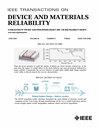From Accelerated to Operating Conditions: How Trapped Charge Impacts on TDDB in SiO₂ and HfO₂ Stacks
IF 2.5
3区 工程技术
Q2 ENGINEERING, ELECTRICAL & ELECTRONIC
IEEE Transactions on Device and Materials Reliability
Pub Date : 2024-04-01
DOI:10.1109/TDMR.2024.3384056
引用次数: 0
Abstract
Despite the various well-established theories such as the thermochemical (E-model),从加速条件到工作条件:捕获电荷如何影响二氧化硅和二氧化铪叠层中的 TDDB
尽管各种成熟的理论,如热化学(E-模型)、$\surd $ E-模型、幂律$(V^{N}$ -模型)和 1/E 模型,都准确地复制了加速条件下介质击穿(BD)的实验趋势,但在预测工作条件下的寿命时,这些理论却存在显著差异。最近引入的载流子注入(CI)模型在一个统一的框架内成功地调和了在上述理论中观察到的差异,揭示了随时间变化的介质击穿(TDDB)电场依赖性可以从热化学到幂律,甚至到 1/E 趋势的变化,这取决于关键原子物种(前体)的微观特性。值得注意的是,这些发现所依据的假设是电介质中的电场仅受外加偏压的影响,而忽略了缺陷和前驱体中俘获电荷的影响。然而,人们认识到,在低外加电压条件下,滞留电荷对氧化物内部的局部电场有很大影响,从而导致加速条件和工作条件之间存在很大差异。有鉴于此,本文将捕获电荷的影响纳入 CI 模型,为二氧化硅和二氧化铪堆栈中的 BD 现象提供了更全面的解释。研究表明,根据材料体系和氧化物中缺陷前体的性质,陷落电荷的存在会导致与传统模型得出的 TDDB 寿命预测值之间出现重大偏差。此外,研究还探讨了陷落电荷和缺陷前驱体位点的微观特性对 TDDB 和通过氧化物的泄漏电流的综合影响。
本文章由计算机程序翻译,如有差异,请以英文原文为准。
求助全文
约1分钟内获得全文
求助全文
来源期刊

IEEE Transactions on Device and Materials Reliability
工程技术-工程:电子与电气
CiteScore
4.80
自引率
5.00%
发文量
71
审稿时长
6-12 weeks
期刊介绍:
The scope of the publication includes, but is not limited to Reliability of: Devices, Materials, Processes, Interfaces, Integrated Microsystems (including MEMS & Sensors), Transistors, Technology (CMOS, BiCMOS, etc.), Integrated Circuits (IC, SSI, MSI, LSI, ULSI, ELSI, etc.), Thin Film Transistor Applications. The measurement and understanding of the reliability of such entities at each phase, from the concept stage through research and development and into manufacturing scale-up, provides the overall database on the reliability of the devices, materials, processes, package and other necessities for the successful introduction of a product to market. This reliability database is the foundation for a quality product, which meets customer expectation. A product so developed has high reliability. High quality will be achieved because product weaknesses will have been found (root cause analysis) and designed out of the final product. This process of ever increasing reliability and quality will result in a superior product. In the end, reliability and quality are not one thing; but in a sense everything, which can be or has to be done to guarantee that the product successfully performs in the field under customer conditions. Our goal is to capture these advances. An additional objective is to focus cross fertilized communication in the state of the art of reliability of electronic materials and devices and provide fundamental understanding of basic phenomena that affect reliability. In addition, the publication is a forum for interdisciplinary studies on reliability. An overall goal is to provide leading edge/state of the art information, which is critically relevant to the creation of reliable products.
 求助内容:
求助内容: 应助结果提醒方式:
应助结果提醒方式:


